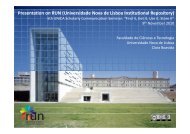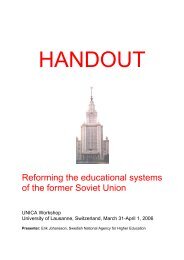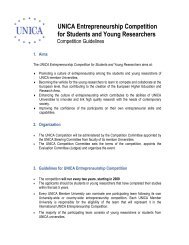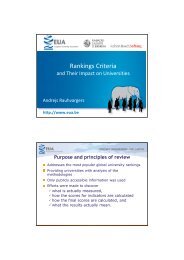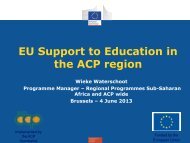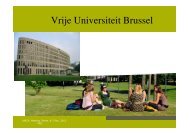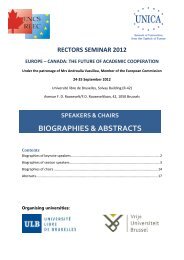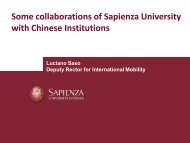Study on the economic and technical evolution of the scientific ...
Study on the economic and technical evolution of the scientific ...
Study on the economic and technical evolution of the scientific ...
Create successful ePaper yourself
Turn your PDF publications into a flip-book with our unique Google optimized e-Paper software.
Since <strong>the</strong>se c<strong>on</strong>tracts are moreover signed for<br />
significant periods <strong>of</strong> time, <strong>the</strong>y tend to rigidify<br />
library budgets <strong>and</strong> make it difficult for potential<br />
entrants to pr<strong>of</strong>itably enter <strong>the</strong> market.<br />
This effect <strong>of</strong> bundling as a deterrent to entry<br />
turns out to be <strong>the</strong> key problem identified by<br />
<strong>the</strong> industrial ec<strong>on</strong>omics literature. Entry<br />
deterrence reduces <strong>the</strong> desirable diffusi<strong>on</strong> <strong>of</strong><br />
knowledge <strong>and</strong> is particularly worrisome at a<br />
time at which <strong>the</strong> electr<strong>on</strong>ic revoluti<strong>on</strong> makes<br />
it especially desirable to leave room open for<br />
new entry <strong>and</strong> new business models.<br />
This report <strong>the</strong>refore stresses <strong>the</strong> importance<br />
<strong>of</strong> promoting pricing policies that limit barriers<br />
to entry. Specifically, (i) <strong>the</strong>re should be no<br />
penalties for net journal cancellati<strong>on</strong>s; (ii)<br />
prices <strong>of</strong> electr<strong>on</strong>ic access (within or without<br />
c<strong>on</strong>sortia) should not depend <strong>on</strong> <strong>the</strong> historical<br />
number <strong>of</strong> print subscripti<strong>on</strong>s, but should<br />
instead be related to actual usage (or number<br />
<strong>of</strong> faculty <strong>and</strong> students) by instituti<strong>on</strong>s; (iii)<br />
increased usage over time should not lead to<br />
price increases if publisher costs do not<br />
increase as a result <strong>of</strong> <strong>the</strong> rise in usage.<br />
Secti<strong>on</strong> 6 c<strong>on</strong>siders <strong>the</strong> bias introduced by <strong>the</strong><br />
higher VAT rate that applies to electr<strong>on</strong>ic<br />
journals vs. <strong>the</strong>ir printed versi<strong>on</strong>, <strong>and</strong> lead<br />
libraries to subscribe to both. This secti<strong>on</strong><br />
describes <strong>the</strong> current situati<strong>on</strong> <strong>and</strong> underlines<br />
that <strong>the</strong> higher rate applied to electr<strong>on</strong>ic<br />
delivery <strong>of</strong> informati<strong>on</strong> in Europe str<strong>on</strong>gly<br />
affects European research instituti<strong>on</strong>s,<br />
especially when compared to o<strong>the</strong>r countries<br />
where electr<strong>on</strong>ic services are exempt from tax,<br />
such as in <strong>the</strong> USA. It examines two possible<br />
soluti<strong>on</strong>s: (i) ei<strong>the</strong>r apply a reduced VAT rate<br />
<strong>on</strong> electr<strong>on</strong>ic <strong>scientific</strong> informati<strong>on</strong>, which<br />
requires an amendment <strong>of</strong> Annex H <strong>of</strong> <strong>the</strong> VAT<br />
Directive; (ii) or introduce a tax refund<br />
mechanism for research instituti<strong>on</strong>s, as in<br />
Sweden or Denmark.<br />
Secti<strong>on</strong> 7 deals with <strong>the</strong> important issue <strong>of</strong> <strong>the</strong><br />
timing <strong>of</strong> access to current research results <strong>and</strong><br />
discusses <strong>the</strong> trade<strong>of</strong>f between <strong>the</strong> advantage<br />
<strong>of</strong> immediate <strong>and</strong> efficient access <strong>and</strong> its<br />
c<strong>on</strong>sequences that would prevent publishers<br />
from legitimately charging readers for <strong>the</strong>ir<br />
output <strong>and</strong> services, <strong>and</strong> eventually lead to <strong>the</strong><br />
disappearance <strong>of</strong> <strong>the</strong> reader/library-pay model.<br />
The evidence discussed in Secti<strong>on</strong>s 3 to 5<br />
points however to a market where publishers<br />
do enjoy market power. This means that access<br />
can be improved significantly before <strong>on</strong>e has<br />
to start worrying about threatening this<br />
reader/library-pay model. At present, immediate<br />
access can be achieved through individual web<br />
pages, through open access repositories or<br />
archives collecting e-prints deposited by <strong>the</strong>ir<br />
authors, <strong>and</strong> through open access journals<br />
which rely <strong>on</strong> various sources <strong>of</strong> income.<br />
In some countries, public authorities have<br />
funded large-scale projects to develop portals<br />
providing free <strong>on</strong>line access to selected<br />
scholarly journals published in <strong>the</strong>ir countries<br />
(e.g. SciELO in Latin American countries,<br />
J-STAGE in Japan, various projects in India).<br />
As an increasing volume <strong>of</strong> research output<br />
from outside Europe becomes openly accessible,<br />
it raises <strong>the</strong> questi<strong>on</strong> <strong>of</strong> <strong>the</strong> visibility <strong>and</strong><br />
accessibility, <strong>and</strong> <strong>of</strong> <strong>the</strong> subsequent potential<br />
impact, <strong>of</strong> European research as most articles<br />
by European researchers are published in<br />
subscripti<strong>on</strong>-based journals. In this respect,<br />
policies like those put in place by <strong>the</strong> U.S. NIH,<br />
<strong>the</strong> UK Research Councils or <strong>the</strong> Wellcome<br />
Trust – which promote open availability <strong>of</strong><br />
research results no later than 12 m<strong>on</strong>ths after<br />
publicati<strong>on</strong> – could be emulated across<br />
Europe, after discussi<strong>on</strong>s with <strong>the</strong> publishers.<br />
The aim could be to ensure that published<br />
European-funded research (at EU, nati<strong>on</strong>al, or<br />
regi<strong>on</strong>al levels) be deposited in st<strong>and</strong>ardized<br />
open archives some time after publicati<strong>on</strong>.<br />
Recent surveys show that a majority <strong>of</strong><br />
researchers seem willing to self-archive <strong>the</strong>ir<br />
articles if induced to do so by <strong>the</strong>ir employer<br />
or funding body.<br />
Secti<strong>on</strong> 7 also discusses more broadly <strong>the</strong><br />
future <strong>of</strong> <strong>the</strong> <strong>scientific</strong> publishing industry.<br />
While <strong>the</strong> reader/library-pay model is still<br />
predominant at <strong>the</strong> moment, it discusses<br />
existing author-pay journals <strong>and</strong> stresses that<br />
experimentati<strong>on</strong> is taking place. It points to<br />
<strong>the</strong> possibility <strong>of</strong> a third model, where <strong>the</strong><br />
reader would ‘really’ pay, that is, would be<br />
charged per article download. All three models<br />
have costs <strong>and</strong> benefits, <strong>and</strong> at this point it is<br />
too early to draw c<strong>on</strong>clusi<strong>on</strong>s <strong>on</strong> desirable<br />
evoluti<strong>on</strong>s (whe<strong>the</strong>r it involves <strong>the</strong> dominance<br />
9




